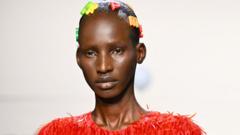Arop Akol is making waves in the fashion industry after three years of captivating audiences worldwide with her unique beauty and style. At a UK agency, First Model Management, the young model shares her experiences walking runways for famous brands in major cities like London and Paris. "I had been watching modelling online since I was a child at the age of 11," Akol states, reminiscing on her journey which includes sharing the runway with supermodel Naomi Campbell.
Among her peers, Akol observes that models from South Sudan are experiencing a surge in popularity, attributed to their stunning dark skin and striking features. South Sudanese models have graced magazines and catwalks globally, including renowned names like Anok Yai, Adut Akech, and Alek Wek, the latter paving the way for many with her Vogue covers and collaborations with high-end brands such as Dior and Louis Vuitton. In fact, a recent ranking highlighted that one in five models on Models.com's "future stars" list have South Sudanese heritage, showcasing their growing influence.
Industry insiders, like Dawson Deng from South Sudan Fashion Week, emphasize the natural beauty of South Sudanese models and their physical attributes which align with current fashion expectations. However, there is curiosity surrounding why they continue to stand out against other nationalities. Casting agent Lucia Janosova notes that while South Sudanese models have a unique appeal, numerous equally talented models exist across various countries.
The appeal of South Sudanese models may also stem from their resilience in overcoming adversity. Akur Goi, another model with roots in South Sudan, explains that her journey involved fleeing her war-torn country for Uganda, where she nurtured her dream to model. On a similar path, Akol faced exploitation after being scouted at a young age before finally signing with a reputable agency in her later years.
Despite their undeniable talent, South Sudanese models frequently encounter obstacles, such as financial exploitation or familial disapproval of their career choice, which some see as akin to prostitution. Akol speaks candidly about her family's initial reluctance but expresses hope as more people in urban areas develop an open-minded perspective toward modeling careers.
While challenges persist, instances of success illustrate the potential for positive change. Some models have managed to become their family's main providers, redefining traditional perceptions. As the fashion industry increasingly seeks diversity, the demand for South Sudanese models shows no sign of diminishing, and with the legacy of pioneers like Alek Wek, the spotlight on South Sudan's models is likely to stay bright.



















